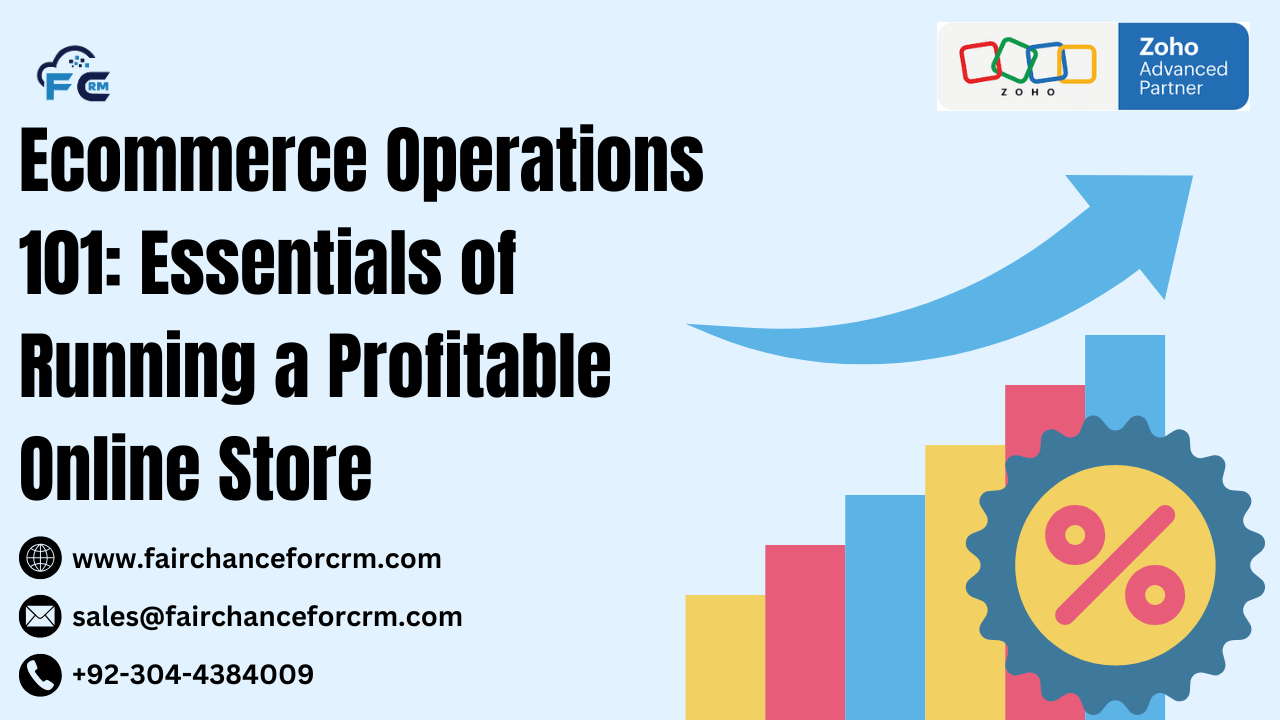Ecommerce Operations 101: Essentials of Running a Profitable Online Store. As customers, we’re used to a seamless shopping experience: browse a site, check out product reviews, add items to a cart, pay, and wait for delivery. It’s simple from our perspective, but for the ecommerce entrepreneur, the process behind the scenes is far more complex.
A company can only increase its online presence, draw in and keep consumers, and experience long-term success by streamlining these processes.
Notwithstanding one’s degree of business ownership experience, understanding the foundations of e-commerce operations is essential to prospering in this fiercely competitive industry. Before we go into the fundamentals of running a successful e-commerce business, let’s first analyze what “ecommerce operations” really mean.
Also Read the related Articles:
- The Ultimate Guide to Ecommerce Marketing | FAIRCHANCE FOR CRM
- 9 Challenges for Ecommerce Businesses and How to Improve
- Automated Email Campaigns in Zoho CRM for E-Commerce Business
- Driving Social Media Sales Utilizing Zoho CRM for E-Commerce
- Why Every E-Commerce Business Needs a Robust CRM?
What Are Ecommerce Operations 101?
The vast range of duties required to operate an online firm is referred to as e-commerce operations. To guarantee a positive client experience, these operations take place in the background. E-commerce operations encompass a wide range of activities, including product procurement, customer acquisition, order fulfillment, and customer service.
In some cases, companies hire an ecommerce operations manager to oversee these tasks. Whatever the size of your company, knowing these fundamentals will help you manage a successful online store. The main areas of e-commerce operations are as follows:
- Product management
- Website & user interface (UI)
- Marketing and customer acquisition
- Ecommerce payment processing
- Inventory management
- Order fulfillment
- Customer support and relationship management
- Data analytics and insights
Now, let’s break down how to successfully manage each of these components.
How to Operate an Ecommerce Operations 101 Business
Three main phases can be distinguished in e-commerce operations: the pre-purchase, purchase, and post-purchase phases. Every step has a distinct set of duties that need to be completed attentively in order to give clients a seamless and satisfying experience.
First Stage: Pre-Purchase Phase
This phase covers everything that happens before a customer makes a purchase. While customers may not be aware of it, a lot of work goes on in the background. Let’s explore the key elements of this phase.
1. Product Management
Managing products online is more challenging than it seems, especially for new businesses. To effectively manage your products, you need to focus on the following aspects:
- Sourcing: Identify where your products or materials come from. Are you working with local suppliers, international wholesalers, or manufacturers? Plan how to get these products to your storage or fulfillment center efficiently.
- Storage: Whether you’re storing products in your home or renting a warehouse, ensure your goods are organized and stored in a suitable environment. Pay attention to conditions like heat and moisture, which can damage certain products like food or leather goods.
- Pricing: Determine the right price for your products by considering production costs, market demand, and competitor pricing. Whether you choose to go with premium pricing, discounts, or competitive rates, make sure your strategy aligns with your brand.
- Labeling: Accurate product labels and descriptions are crucial since customers can’t physically interact with products online. Include all relevant details, such as product ingredients, size, color options, usage instructions, and any warnings or certifications.
- Cataloging: Keep your product catalog updated with clear descriptions, high-quality images, and accurate pricing. Creating product categories and variations (such as different colors or sizes) will make shopping easier for your customers.
2. Website and UI
A well-designed website with a simple and intuitive user interface (UI) can make or break your business. Just like a confusing physical store can drive customers away, a poorly designed website will result in lost sales. According to research, a great UI can boost your website’s conversion rate by up to 200%.
Key design elements to include:
- Input Controls: These elements help users interact with your site. They include things like text fields, checkboxes, radio buttons, and drop-down menus.
- Navigational Elements: Guide your customers through the website with tools like search bars, menu navigation, breadcrumbs, and image carousels. These features make it easier for customers to find what they need.
- Informational Elements: Provide clear feedback to your customers through pop-ups, modal windows (used for confirmations), progress bars, and scroll bars. These elements enhance the overall shopping experience.
When building your Ecommerce Operations 101 site, consider platforms or website builders that offer easy-to-use tools and strong security features, especially if you’re not building the site from scratch.
3. Marketing and Customer Acquisition
Marketing is essential for driving traffic to your ecommerce site and turning visitors into customers. Here’s a quick guide to kickstart your marketing efforts:
- Executive Summary: Describe the vision, mission, target market, and marketing objectives of your business. You can use this as a reference for your upcoming marketing plans.
- Funnel Marketing: Divide your marketing strategy into the top, middle, and bottom funnel stages. At each stage, you’ll target different segments of customers—from first-time visitors to repeat buyers.
- Marketing Channels: Reach your audience with a range of platforms, including blogs, social media, pay-per-click (PPC) advertisements, email marketing, and more. Programs for affiliate marketing are another way to boost traffic and conversions.
You can improve the performance of your marketing campaigns and client behavior by monitoring the latter.
Second Stage: Purchase Phase
Once you’ve attracted a customer, the purchase phase begins. The actual transaction takes place here, thus it’s critical that your procedures run smoothly and securely.
4. Ecommerce Operations 101 Payment Processing
Processing payments is one of the most important parts of online shopping. Payment problems may cause disgruntled clients and decreased revenue. Here’s what you need to focus on:
- Payment Methods: Offer multiple payment options, such as credit cards, digital wallets (like Google Pay or Apple Pay), and cash on delivery. Providing for a variety of tastes will increase your conversion rate.
- Payment Gateway: Integrate a reliable payment gateway like PayPal, Stripe, or Authorize.Net to handle transactions securely. The payment gateway guarantees the safe transmission of money between your store and customers by encrypting sensitive data.
- Security Measures: Use security measures like SSL certificates, PCI DSS compliance, and fraud detection software to safeguard the information of your clients.
5. Inventory Management
Poor inventory management can lead to either overstocking or running out of stock—both of which hurt your business. Here’s how to stay on top of your inventory:
- Inventory Techniques: Use strategies like Just-In-Time (JIT) inventory, First In First Out (FIFO), or ABC analysis to manage stock levels efficiently.
- Inventory Forecasting: Use sales data and market trends to predict demand and avoid stockouts or overstocking.
- Inventory Management Tools: Consider automating inventory tracking with software that integrates with your Ecommerce Operations 101 platform. This ensures real-time inventory updates and reduces errors.
6. Order Fulfillment
Order fulfillment is the backbone of your Ecommerce Operations 101 business. Fast shipping, accurate order processing, and proper packaging contribute to customer satisfaction. Here’s what you need to know:
- Order Fulfillment Methods: Choose between self-fulfillment (you handle everything), third-party logistics (3PL), or dropshipping (the supplier handles stock and shipping).
- Packaging: Ensure your packaging is secure, eco-friendly, and reflects your brand. Offering premium packaging or unique unboxing experiences can set you apart from competitors.
- Shipping and Logistics: Research shipping carriers and negotiate rates to ensure fast, reliable delivery. Integrate shipping with your Ecommerce Operations 101 platform to provide real-time tracking updates to customers.
Third Stage: Post-Purchase Phase
The customer journey doesn’t end after a sale. Retaining customers is key to long-term success, and this is where customer support and relationship management come in.
7. Customer Support and Relationship Management
A strong relationship with your customers leads to higher retention rates and more sales. Here’s how to provide exceptional support:
- After-Sales Service: Address common post-purchase issues like shipping queries, returns, or product usage questions. Automate responses where possible, but ensure human support is available when needed.
- Help Desk: Use help desk software to streamline support tickets and ensure issues are resolved quickly and efficiently.
- Feedback: Collect customer feedback to understand their experience and make improvements. Surveys, reviews, and feedback forms are valuable tools to measure customer satisfaction.
8. Data Analytics and Insights
Finally, leverage data analytics to make informed business decisions. Understanding customer behavior, sales trends, and website performance will allow you to continuously optimize your operations.
- CRM Systems: Customer Relationship Management (CRM) tools help you track customer interactions, send personalized marketing messages, and manage customer data in one place.
- Ecommerce Reports: Dive into traffic reports, sales performance, and abandoned cart data to identify areas for improvement and increase conversions.
Conclusion
Running a successful Ecommerce Operations 101 business involves much more than just setting up a website and selling products. From managing inventory to providing stellar customer support, every aspect of ecommerce operations plays a crucial role in your business’s success. By focusing on each of these areas—product management, website UI, marketing, payment processing, inventory, order fulfillment, and customer relationships—you can create a smooth and rewarding experience for your customers, driving growth for your ecommerce business.
FAQs
1. What is inventory management for e-commerce?
The process of monitoring and controlling the stock of goods up for sale online in order to maintain precise quantities and avoid overstocking or product shortages is known as e-commerce inventory management.
2. In e-commerce, why is user interface (UI) important?
Customers will have a smoother, simpler time browsing, choosing products, and completing purchases with a well-designed user interface (UI), which will ultimately increase conversion rates.
3. What kinds of payments need to an online store accept?
To satisfy a wide range of consumer preferences, e-commerce sites ought to include a selection of payment methods, such as bank transfers, digital wallets, debit cards, credit cards, and cash on delivery.
4. How can data analytics help an online retailer?
Data analytics aids companies in comprehending consumer behavior. Businesses may watch sales trends, better understand customer behavior, and streamline processes with the use of data analytics, which results in more profitable decisions.
5. What function does an e-commerce payment gateway serve?
A payment gateway encrypts sensitive data and makes it easier for money to be sent to complete purchases, ensuring that transactions between customers and your store are processed safely.




